





The past twenty years have seen a deluge of new motoring market niches being discovered or even created, and then promptly filled by the car manufacturers of the world, as the number of different models that they are able to offer has increased massively. Probably no bigger new market segment has emerged than the transformation of the 4×4 from being the true off-roader typified by the Land-Rover Defender to a whole panapoly of SUVs, soft-roaders and other cross-over type vehicles. Although public appetite for these creations took many of the manufacturers by surprise, it was no long before many were offering competitors somewhere in the segment. Surprisingly, Ford of Europe – masters of marketing just the right sort of car in the right sort of variants to the right people at the right time for so long – seem to have struggled to find success in this sector. Their first effort was the tie-up with Nissan which gave us the Maverick and Nissan Terrano, hardly the most desirable cars of their type even when new on the market in 1993.




Attempts to sell the US model Explorer were even less successful, as the car was too big and thirsty for European tastes. Although initially praised, the next generation Maverick, based on the US market Escape was a flash in the pan, as well. And then in 2008, we got the Kuga. Designed for Europe, with the underpinnings of Ford’s much praised volume selling hatchbacks, it immediately received approbation from the motoring press, and was generally regarded as being best in class. Over the past couple of years, I’ve driven some of the Kuga’s competitors, and none of them left me feeling like they were “best in class”, so I was quite keen to see if the Kuga was indeed worthy of the praise that was lavished on it at launch.





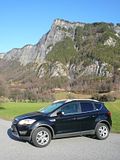
The test nearly did not get started, though. Mr Hertz gave me a key fob, and instructions that as long as it was in the car, all I had to do was to depress the clutch pedal, and press the button marked “power” in the centre of the dash between the air vents and the car would start. Indeed, there is just a blanking plate on the steering column and there is no slot to insert the “key” on the dash. Accordingly, I went into the rental car garage, pressed “unlocked” and struggled to get into the boot. After a good few minutes effort, I gave up, thinking I must be doing something wrong, and went in search of the Hertz agent. He had no more success than me, so after checking it was the right car (it was!), and that we could get into the passenger compartment, he spotted that the lights were on. It transpired that they had been on all night and the battery was as dead as they come. Luckily, Hertz had another Kuga, so I went back to get the paperwork for a Panther Black one rather than a Sea Grey car, and the test was back on.

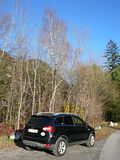




Word of warning, though. If the lights are on when you press “power” to stop the engine, although a warning buzzer sounds, they do not extinguish, so you could easily do as the Hertz delivery person had done! After this little challenge, I really got to like the system, as I could leave the key in my pocket as I hopped in and out doing road test photo duty. When it came to lifting the bonnet, I was initially challenged, though. Like many recent Fords, there is no internal release, but you swivel the grille Ford motif, and there you find a conventional key lock. Hmm! Not easy with a blunt stub, then I spotted that if I pushed a bit of plastic in the end to one side, I could extract what turned out to be a tiny flimsy key thing which hides in the main key fob, and lo, you could insert it and twist to left then right to lift the bonnet.



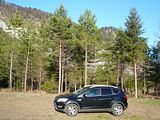
Earlier this year, Ford slotted the 5 cylinder 2.5T engine under the bonnet of the Kuga, this introducing a choice of petrol or diesel engine, but it is widely expected that the majority of sales will remain for the oil burner. The diesel engine is the 136 bhp 2.0 litre engine, and I have to say that every encounter I have with this source of motive power seems worse than the last. In this application the noise and roughness on start up was a great reminder of why many people just did not take to diesel propulsion for so many years. Once the engine warmed up, much of the unpleasant and characteristic diesel rattle abated, but at all times apart from steady speed cruising on the autobahn, you were only too aware that this was an oil burner. It is not all bad news, of course, because this also means oodles of torque and more usable power than an equivalent petrol engine would give you. It allows you to propel the Kuga forward in among the traffic quite well, and endows the car with far more urge than I experience in its predecessor, the hapless 2.3 litre petrol engined Maverick.




There are six forward gears, selected using a very slick-changing gear lever that is mounted quite high in the centre console. There is quite a lot of travel between the gears, especially those in the lower half of the “H” pattern, and in sixth, the lever is virtually horizontal. This does meant that as you slot the lever into sixth, you find your arm resting on the centre armrest. Whereas the Kuga does not quite have the delightful feel and precision to its steering that you would find in a Focus, it is not bad, and indeed far better than any of its competitors, and if you couple this with handling which made it feel like I was driving a low-slung hatchback and not some top heavy SUV with a high centre of gravity, I think you can see why the Kuga got such good write ups when it was launched. Even over some less than smooth roads, it seemed to ride quite well, too. Not quietly, though. There was far too much road noise and a surprising amount of wind noise, and if you couple this with an annoying vibrating rattle somewhere just by the driver’s side air vent, this was not as restful a motorway cruiser as the high sixth gear would encourage you to hope for. Like other Ford products, there is no driver’s footrest, but on this left hand drive test car, there is a nice flat part of the wheel arch on which you can rest your clutch foot when it is not in use. Right hand drive cars would not be so well off, of course. A rather better surprise was the all round visibility. The rear side windows are quite small, so you would expect significant blind spots when reversing, but I found far fewer challenges than with many recent vehicles in judging the extremities.
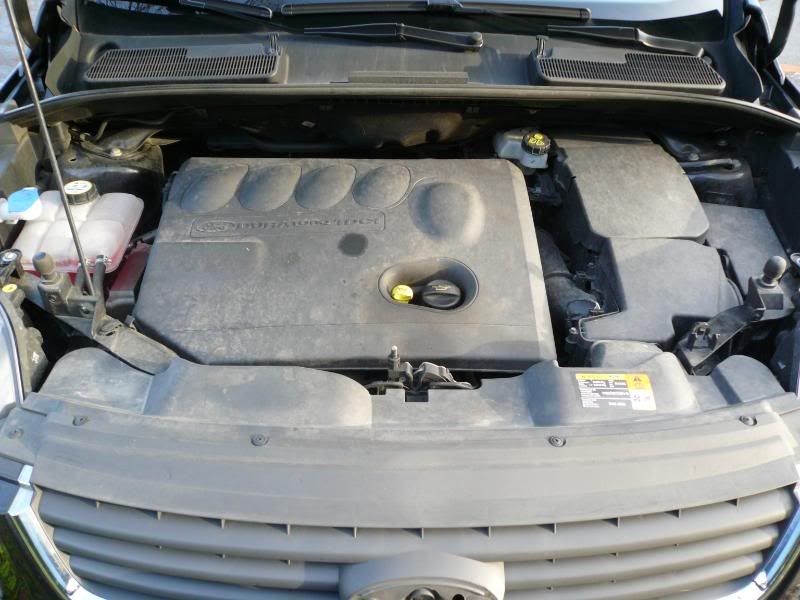



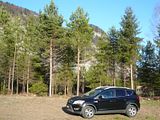
If the agricultural sound on start up was one unpleasant surprise, there was a far nastier one that greeted me on getting in. A swathe of blue plastic surrounds the centre console, even on this rather soberly finished black exterior with dark grey interior car, and there is a matching trim to the armrests on the doors. The plastic is of a particularly low grade, reminding me of a thinner cheaper version of the sort of stuff that my recycling box is made of. I have to say that it is just truly horrid, and whatever possessed Ford to put that on the car, I cannot imagine. As there is also a stripe of a similar blue in the seat backrest, I assume that they thought that this would liven up what could otherwise be a rather dull interior. Research on Ford’s website suggests that there are versions of the Kuga that are devoid of this visual abomination, so you would need to choose your spec very carefully, unless you happen to like it.




Whilst I am complaining, the same tawdry fake metal effect plastic moulding surrounds the small dials in the dash that sit between the speedo and rev counter, and is both horrid to look at and very cheap looking indeed. It is the same as you find in the facelifted Focus, and it’s ghastly there, too. The rest of the dash is indeed very similar to a Focus, and in all other respects that means goodness. The main dash moulding is of good quality, soft-feel plastic, and it looks agreeable to the eyes. The dials are clear, the controls are of good quality and easy to use. Two main dials are augmented by smaller ones for fuel level and water temperature and there is a trip computer display between the larger dials. There is a large Ford-standard remote for the stereo system to the lower left of the column, and there is a large light switch on the left of the dash. The central part of the dash is also finished in a sort of cheap-effect silver plastic, and this surrounds the stereo and air con systems.The test car – in Swiss spec – came with air conditioning, but not climate control, which was simplicity itself to use. It did have a heated front screen and the heating elements were so fine you could barely see them even in bright sunshine. The wipers did a good job, and I was interested to see that the design of the rear of the car is such that when moving on a rainy autobahn the rear window stayed almost completely clear, which is quite unusual for any vehicle with a pretty upright tailgate.


One of the supposed reasons for the popularity of cars of this genre is for the extra space inside them. Not only is there more than ample headroom in the Kuga, but there was decent rear legroom, too. The boot is quite a bit larger than you would get in a Focus, and you can readily fold down the asymmetrically split rear seats, to get more space. The rear seat cushions lift up first, thus providing a sort of barrier to the front seats. In the cockpit, the average sized glove box is complemented by door bins, with a smaller pocket in front and above this, space under the central armrest, two cup holder areas in the centre console and a small stowage area in the top centre of the dash, which had an ill-fitting plastic moulding which was coming to pieces.



Once upon a time, Ford cars were notable for their value for money, but a series of price rises in 2009 have made many of their products downright expensive, and none more so than the Focus. Compared with the ambitious price tags on their volume seller, the Kuga seems more realistically priced. That said, the test car, in Swiss spec that they call “Carving”, was far from luxurious. Indeed, I would go as far as to suggest that it had the basics covered, and no more: a standard issue stereo/CD system, air conditioning, alloy wheels, front fog lights, leather covered steering wheel, privacy glass on the side windows and the keyless ignition were about the only items of note.



I would love to say that I was as impressed by the Kuga as the rental rep said I would be. Sadly, I was not. It needs a more refined engine to lessen the assault on my ears. And it needs to get rid of the utterly repulsive Fisher-price blue plastic trim in the cabin to lessen the assault on my eyes. Fix those, and this could well be a class-leading SUV. Until these things are sorted, I suspect the SUV I would pick, were I to choose such a vehicle to own for longer than a rental, comes from Mlada Boleslav in the Czech Republic. Yes, I need to test a Yeti, because on paper, it looks like it could be the one to beat.




2009-11-24 07:04:15






































































































